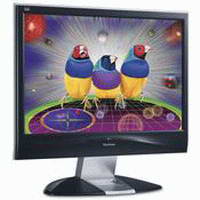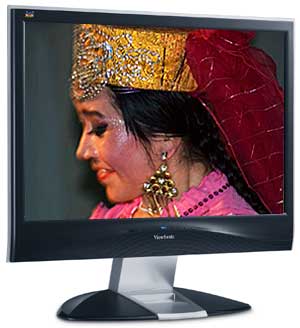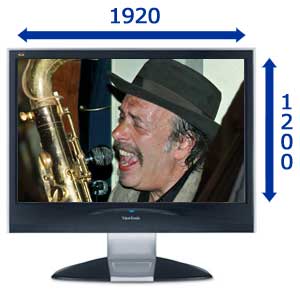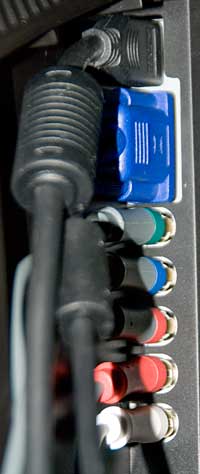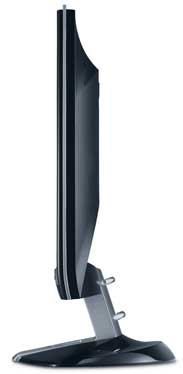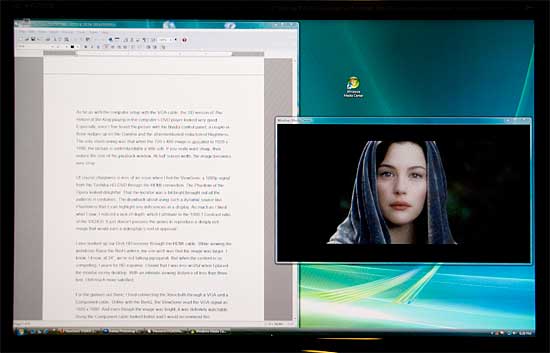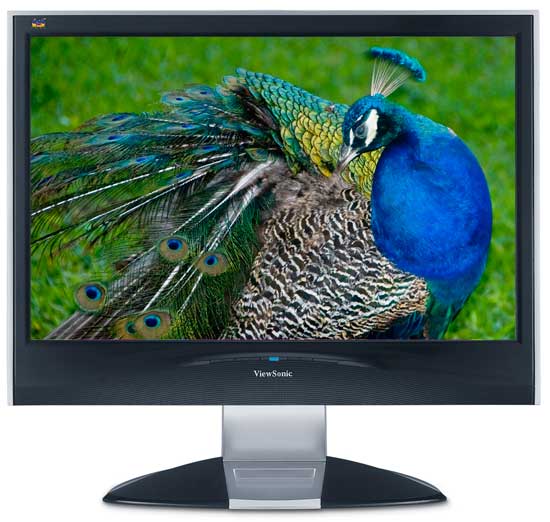
|
|
 |

|


Dick De Jong July 20, 2007 HDTV Solutions The VX2435 24" LCD Monitor is ViewSonic's entry into the growing new breed of computer monitor/HDTV hybrids that can handle both computer (16 x 10, WUXGA, 1920 x 1200) and HDTV (16 x 9, 1080p) signals. I've become interested in these crossover products, (see our review of a related unit, the BenQ FP241WZ), as the trend of computers acting as home media centers has accelerated. I realize that if you are just streaming videos from Internet sites like YouTube or all your source material has been downloaded to your hard drive, you really wouldn't require anything more than a good computer monitor. But especially in a small space like a dorm room, consider the convenience of having one unit that can stream Desperate Housewives from ABC.com (through your computer‘s VGA), play NCAA '08 Football (through Xbox's Component out), and display the 1080p high definition DVD of Babel (via HDMI out of either a Blu-ray or HD-DVD player). I don't want to mislead you, the VX2435 is not a total TV viewing solution because it does not have a TV tuner, neither NTSC nor ATSC. So if you want to watch broadcast TV, you will need a portable TV tuner like the Hauppauge WinTV HVR950 or plug into a cable or satellite set top box.
The ViewSonic does provide integrated speakers. I appreciate the gesture and for basic TV playback, they suffice. Though I would suggest if you are serious about your audio fidelity, you should invest in a more barrel-chested speaker system. Out of the Box The screen does tilt backwards and forwards but it does not swivel left or right or slide up and down on the stand, so you may find that you have to lift or twist the whole weight to position it perfectly. Though the VX2435's screen size (24" diagonally), aspect ratio (16 x 10) and native resolution (1920 x 1200) are the same as the BenQ FP241WZ, the ViewSonic looks smaller because the surrounding black bezel is larger at the bottom to accommodate the speakers.
The control buttons are discreetly located in the middle on the front below the screen. Actually, if it weren't for the blue On/Off button, it would be easy to pass over the whole row of five because their blackness is camouflaged in the bezel. Only in the right light and with a magnifying glass, can you perceive the arciform cutout of buttons and the little numbers indented in them. I don't have pudgy fingers and I still feel clumsy pushing these buttons that are only minimally raised from the bezel's surface. I can only imagine the unease the more ham-handed, nail biters among us might have with these controls. I might suggest a stick on nail for your pointer finger. The ability to navigate these nubby protuberances is crucial because there is no remote control, so pushing the buttons is the only way that you can make picture adjustments, select inputs, or even raise and lower the volume. Luckily everything is in front of you so you don't have to fiddle with buttons on the side of the monitor. Still, making the simplest adjustment is often a three or four step unwieldy process. For example, I sorely miss a remote when I want to mute the audio when I receive a phone call. I have to push the 1 button to bring up the On Screen Display (OSD). Then either the 3 or 4 buttons to move to the Audio Adjust menu. Then 2 to enter, then 3 to find Mute, then 2 to select, and 1 to exit, and the sound is muted. Of course, after that 1-3-2-3-2-1 fox trot, the phone isn't ringing anymore and it‘s 1-3-2-3-2-1 again to unmute. Next time, I'll just turn the monitor off. I know remote controls are not standard issue for computer monitors, but the expectations of TV users are different and for crossover products like this ViewSonic, a remote, if not part of the included gear, should at least be available as an add-on.
The connection panel is divided in two with one part on each side of the back facing out for easier access. On the left are the HDMI, VGA and Component (with RCA stereo audio) inputs. On the right are the S-Video, RCA stereo audio, Composite, and mini jack audio inputs. When all the cables are connected they can be concealed with black covers that snap into the back of the monitor. The base also furnishes two loops to assist in your attempt to corral the cable clutter. One connector that is obvious by its absence is a DVI-D input. If you wish to make a direct DVI-D connection from your computer's video card to the VX2435, ViewSonic does include a DVI-D to HDMI cable. However, with only one HDMI input on the monitor, you will have to decide whether you will use it for a computer or an HDTV connection. I suppose you could switch out cables depending on your source. But that solution is made even more cumbersome because, at least for me, attaching the HDMI cable in the tight upper corner of the connection panel was much more difficult than you would imagine. (Here's a hint, plug in the HDMI cable before you attach the neighboring VGA connector.) Setup I have a Dell Dimension 520 running Vista with an NVidia GeForce 7300 LE video card and the monitor is attached with a VGA cable. As usual, I tested settings on the Digital Video Essentials DVD, (the SD version) playing on the computer‘s DVD player. But since I was in the Windows domain, I also ran through the Windows Media Center monitor setup. The Windows video clip provided to adjust Brightness shows a dude dudded out in a black suit with a sheeny black shirt chalking a black pool cue. In the black background is a black X on a black stick moving back and forth. To achieve the proper setting, you lower Brightness until the black X disappears into the darkening background. Even with Brightness pushed all the way to 0, the X was still visible. The same result was true with the Brightness test patterns playing from the DVD player in the computer. Of course, depending on your computer and its video card, you may have totally different results. I finally had to turn the Brightness setting in my NVidia display control panel down to 32 to make that persistent X vanish. At this proper video display, I was shocked by how dull a blank white page looks in my word processing program. But I also realized that if this default Brightness setting was any indication of most computer monitors that I have owned, (and I believe it is), then I have been over illuminating my retinas for years.
Once I had adjusted the internal video setup, I plugged in the Toshiba HD-A20 HD-DVD player with an HDMI cable. I ran through the test patterns again and the Brightness and Contrast settings were almost the same. Luckily, with Brightness turned down to 5 - I just couldn't force myself to drop it all the way to 0 - the black level was acceptable. I say luckily because with HDMI, the NVidia video card is out of the picture as is the NVidia control panel. In its OSD, ViewSonic offers a fairly robust toolkit for image adjustment. To tweak colors you can use the usual Tint and Color controls or open up the Color Adjust menu. Inside, you can choose from a list of preset Color Temperature values, (5400K, 6500K, 7500K, 9300K, and sRGB). Or if you select User, you can increase or decrease individual R, G, B sliders. The OSD also provides an OptiColor menu with presets for Standard, Text, Cinema, Game, Portrait, Scenery and Vivid. Being somewhat of a control freak when it comes it adjusting my picture, I tend to stick with Standard and then fine tune with other controls. Though I always suggest that you take these presets out for a spin and see if you are invigorated by Vivid or stimulated by Scenic. Performance As far as with the computer setup with the VGA cable, the SD version of The Return of the King playing in the computer's DVD player looked very good. Especially, once I fine tuned the picture with the NVidia control panel, a couple or three nudges up on the Gamma and the aforementioned reduction of Brightness. The only shortcoming was that when the 720 x 480 image is upscaled to 1920 x 1080, the picture is understandably a little soft. If you really want sharp, then reduce the size of the playback window. At half screen width, the image becomes very crisp.
Of course sharpness is less of an issue when I fed the ViewSonic a 1080p signal from the Toshiba HD-A20 through the HDMI connection. The Phantom of the Opera looked delightful. That the monitor was a bit bright brought out all the patterns in the costumes. The drawback about using such a dynamic source like Phantom is that it can highlight any deficiencies in a display. As much as I liked what I saw, I noticed a lack of depth, which I attribute to the 1000:1 Contrast ratio of the VX2435. It just doesn't possess the genes to reproduce a deeply rich image that would earn a videophile's nod of approval. I also hooked up our Dish HD receiver through the HDMI cable. While viewing the luminous Raise the Red Lantern, my one wish was that the image was larger. I know, I know, at 24", we're not talking pipsqueak. But when the content is so compelling, I yearn for HD expanse. I found that I was less wistful when I placed the monitor on my desktop. With an intimate viewing distance of less than three feet, I felt much more satisfied. For the gamers out there, I tried connecting the Xbox both through a VGA and a Component cable. Unlike with the BenQ, the ViewSonic read the VGA signal as 1920 x 1080. And even though the image was bright, it was definitely watchable. Using the Component cable looked better and I would recommend this connection.
Finally, the convenience of the VX2435's integrated speakers is offset by the difficulty of controlling the volume. Though the sound that emanates from those tiny tweeters can sometimes pleasantly surprise you, the bass response is anemic. If you're planning on watching DVDs, please purchase a separate audio system. Conclusion
First, realize, that ratings are relative to when the review was written. The obvious example is Value, what you could purchase for $2000 two years ago or even two months ago would seem like a bad value for that price now. Second, we have given only a few 5 Star ratings, which we reserve for truly outstanding accomplishment. Performance: 4 Features: 4 Ease of Use: 4 Value: 4.5 |
Bookmark:
![]() del.icio.us
del.icio.us
![]() Reddit
Reddit
![]() Google
Google
| Send this Page | Print this Page | Report Errors |




